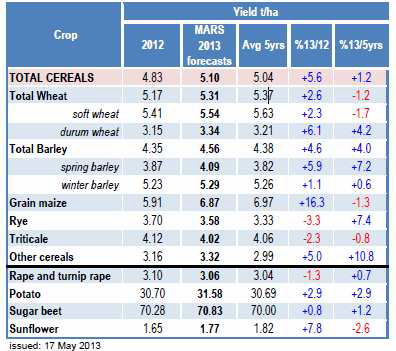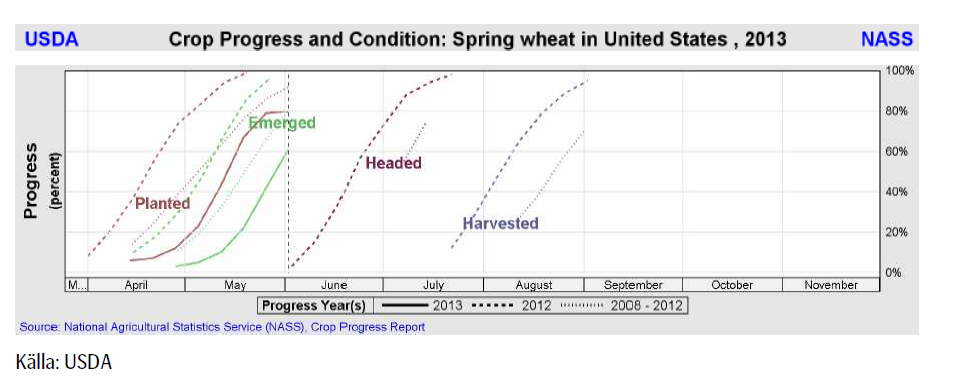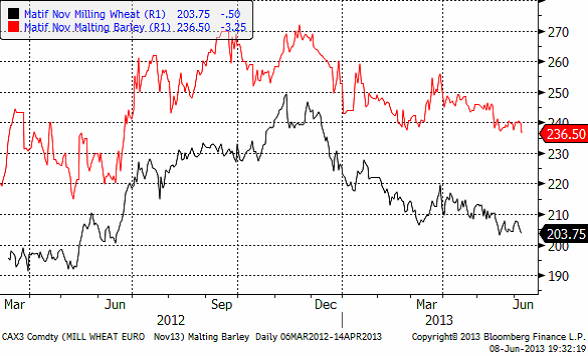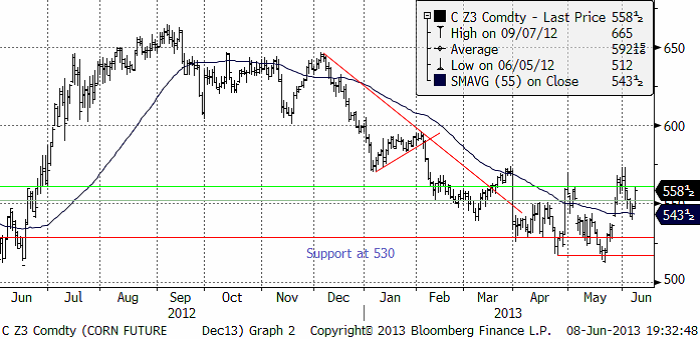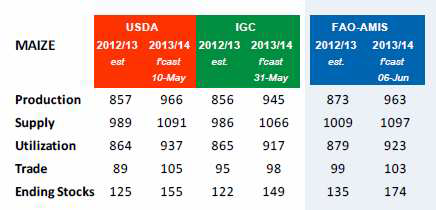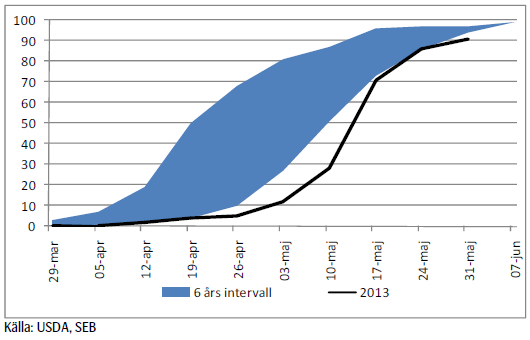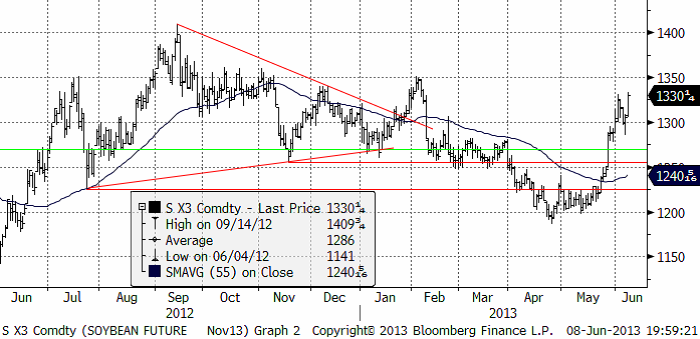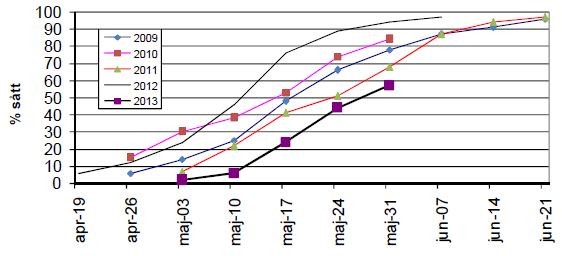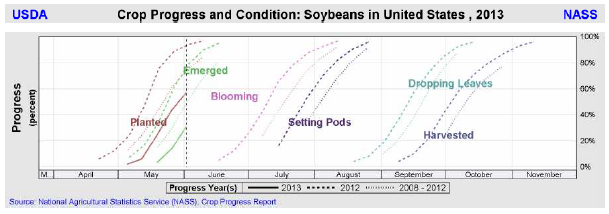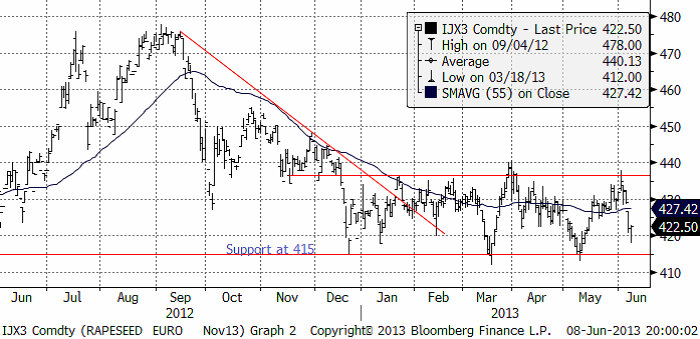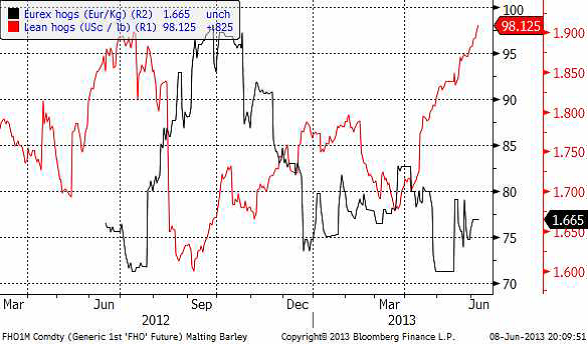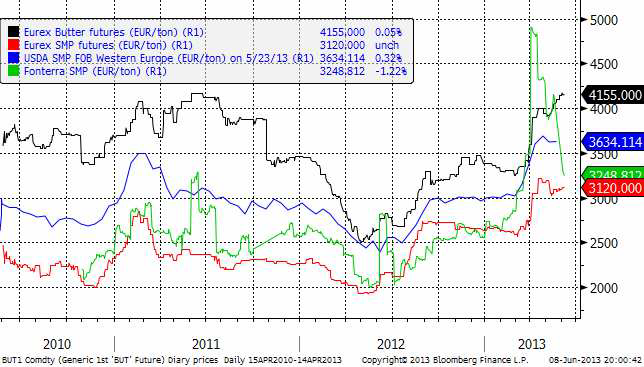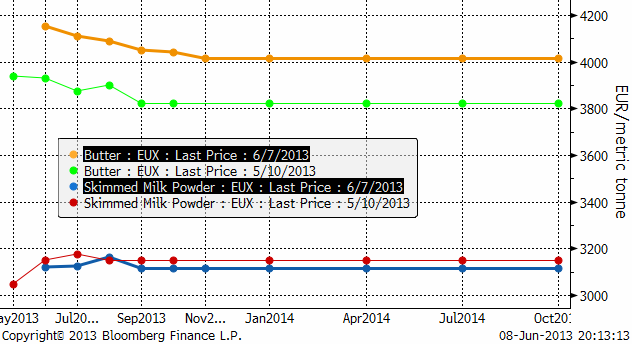Analys
SEB Jordbruksprodukter, 10 juni 2013
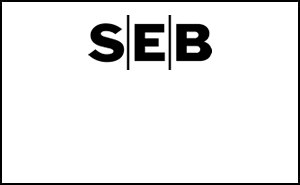
 Priset på vete har gått ner något på Matif i veckan. Sojabönor har stigit ganska mycket, men ligger precis under ett tekniskt motstånd. Rapspriset på Matif gick i motsatt riktning. Den främsta förklaringen är att medan vädret är ogynnsamt för sojabönorna i USA, är det gynnsamt för rapsen i Europa och framförallt i Kanada. Grispriserna går åt helt olika håll i världen. Medan priset på den tyska Eurex-börsen är nära tvåårslägsta, har Lean Hogs noterat tvåårshögsta i Chicago. Fonterra-noteringen har fortsatt att falla, men priset på SMP har hållit sig stabilit på Eurex, samtidigt som terminspriset på smör stigit.
Priset på vete har gått ner något på Matif i veckan. Sojabönor har stigit ganska mycket, men ligger precis under ett tekniskt motstånd. Rapspriset på Matif gick i motsatt riktning. Den främsta förklaringen är att medan vädret är ogynnsamt för sojabönorna i USA, är det gynnsamt för rapsen i Europa och framförallt i Kanada. Grispriserna går åt helt olika håll i världen. Medan priset på den tyska Eurex-börsen är nära tvåårslägsta, har Lean Hogs noterat tvåårshögsta i Chicago. Fonterra-noteringen har fortsatt att falla, men priset på SMP har hållit sig stabilit på Eurex, samtidigt som terminspriset på smör stigit.
På onsdag är det dags för WASDE-rapport igen. Några av Bloombergs analytiker-estimat för de mest centrala posterna finns redan att notera inför onsdagen. Du ser dem i nyhetskalendern längre ner i det här brevet.
MARS
 EU Kommissionens MARS-enhet gjorde en marginell justering nedåt i sin senaste rapport gällande den genomsnittliga avkastningen för vete, majs och oljeväxter medan en marginell justering uppåt gjordes för korn. Varmare temperaturer i bl.a västra Europa har fått fart på grödornas utveckling efter den kalla våren, även om det fortfarande finns märkbara fördröjningar gällande höstgrödorna – framförallt i Storbritannien men även i Benelux länderna – men överlag så kvarstår de nuvarande utsikterna för EU-27 i stort sett i linje med genomsnittet.
EU Kommissionens MARS-enhet gjorde en marginell justering nedåt i sin senaste rapport gällande den genomsnittliga avkastningen för vete, majs och oljeväxter medan en marginell justering uppåt gjordes för korn. Varmare temperaturer i bl.a västra Europa har fått fart på grödornas utveckling efter den kalla våren, även om det fortfarande finns märkbara fördröjningar gällande höstgrödorna – framförallt i Storbritannien men även i Benelux länderna – men överlag så kvarstår de nuvarande utsikterna för EU-27 i stort sett i linje med genomsnittet.
Prognosen för EU-27’s vete justerades ner till 5.54 t/ha från förra månadens 5.63 t/ha, vilket fortfarande är en ökning med 2.3% jämfört med förra året men strax under det femåriga genomsnittet på 5.63 t/ha. Detta som en följd av indikationer om lägre avkastning i Storbritannien och Irland där grödorna ligger ca 2-3 veckor efter i sin utveckling samt i Baltikum, Ungern, Tjeckien, Polen och Danmark. Estimatet för Storbritannien justeras ner från 8.02 t/ha till 7.68 t/ha då grödorna har blivit hårt drabbade av förra årets rekordregn, som påverkade förra årets skörd och sådden av årets grödor.
Estimatet för EU-27’s majs reviderades ner från förra månadens 6.96 t/ha till 6.87 t/ha, som dock är en ökning med 16.3% sedan 2012. Norra Italien har drabbats av kraftiga regn under maj månad vilket har försenat sådden av majs. MARS lämnar dock sin prognos för Italien oförändrad för nu, med reservationer för revideringar i avkastningen nedåt framöver. Prognosen för korn justerades däremot upp och ligger nu på 4.56 t/ha, en ökning från förra månadens 4.48 t/ha. Framförallt görs en rejäl uppjustering av höstkorn i Spanien med 25% medan marginella justeringar nedåt görs för t.ex Tyskland och Frankrike. Även avkastningen för vårkorn justeras upp med nästan 4%, också detta på grund av gynnsamma utsikter i Spanien.
Avkastningen för raps och rybs justeras ner marginellt från 3.09 t/ha till 3.06 t/ha då utsikterna för Storbritannien, Rumänien, Ungern och Slovakien har försämrats och inte kompenseras av revideringen uppåt för Polen och den marginella förbättringen i Tyskland.
Vete
Priset på novemberterminen på Matif föll till 203.75 euro per ton i veckan som gick. Detta trots att Egypten bett Frankrike om hjälp med spannmålsförsörjning, lagring och finansiering av detta, översvämningar i östra Tyskland och att EU-Kommissionen sänkt skördeestimatet med 2 mt till 127.9 mt. Trots allt är det en större skörd än förra årets 123.8 mt.
Decemberkontraktet på CBOT har inte visat stora tecken på att vilja gå ner. 700 cent utgör ett starkt stöd, liksom 758 cent ovanför utgör ett motstånd. Just nu och de kommande dagarna ser det ut att finnas möjlighet till ytterligare prisnedgång, ner mot 700 cent kanske och ett test av den nivån.
Nedan ser vi förändringen i terminskurvorna fredag till fredag. Vi ser att Matifs terminsmarknad har sjunkit betydligt mer än den amerikanska.
IGC justerar upp sin prognos för den globala produktionen av vete 2013/14 med 2 mt till 682 mt, en ökning med 4% på årsbasis till följd av högre areal och avkastning, men justerar samtidigt upp sitt estimat för den globala konsumtionen med 2 mt till 680 mt.
FAO-AMIS säger att den globala veteproduktionen 2013/14 förväntas slå rekord och justerar upp sitt estimat till 702 mt, en ökning på 6.5% på årsbasis, på förväntningar om en återhämtning i Europa och Svarta Havsregionen . Konsumtionen förväntas öka med 1.1% där användningen av foder förväntas återgå till mer normala nivåer medan livsmedelskonsumtionen fortsätter att hålla jämna steg med befolkningstillväxten.
Måndagens Crop Progress rapport från USDA visar på marginella förändringar för det amerikanska höstvetet. För de 18 stater som rapporterar så klassas 32% som ”good/excellent”, upp 1% från förra veckan men väl under förra årets 52% vid samma tid. Höstvete klassat som ”poor/very poor” uppgår till 43%, också det en ökning med 1% från förra veckan och väl över förra årets 18% vid samma tid. Andelen höstvete som har gått i ax fortsätter dock att ligga under genomsnittet, både i de HRW och i de SRW producerande staterna, som en följd av den kalla våren. Per den 2 juni hade 73% gått i ax, vilket är att jämföra med förra årets 88% vid samma tid och det femåriga genomsnittet på 80% vid denna tidpunkt.
Sådden av vårvete i de 6 största staterna gjorde små framsteg i veckan som gick och är nu avklarad till 80%, upp endast 1% från vecka innan och fortfarande efter förra årets 100% och det femåriga genomsnittet på 92%.
Den största producenten, North Dakota, ligger fortfarande sist med endast 64% av sådden avklarad, jämfört med dess femåriga genomsnitt på 89% vid den här tiden. Rapporten visade också för första gången tillståndet för vårvetet, varav 8% klassas som ”poor/very poor”, medan 64% klassas som ”good/excellent” – att jämföra med förra årets 2% resp 78%.
Slutsatsen är att vi behåller vår säljrekommendation på vete.
Maltkorn
Maltkornet höll sig någorlunda starkt i veckan, men om vetet fortsätter ner, får vi nog se ett nedställ på maltkornet också. Trenden är tydligt nedåtriktad.
Majs
Majspriset (december 2013) har liksom vetet fått stöd den senaste tiden. Efter årslägsta notering i slutet av maj har priset stigit kraftigt uppåt, rekylerat ner och i fredags börjat ett nytt försök uppåt. Än så länge rör sig priserna under den nivån som uppnåddes innan plantings-rapporten från USDA i slutet av mars, men ett test av den nivån kan komma och i så fall kan priset nå ändå upp mot 600 cent. Det vore verkligen ett ödets ironi att vad som väntas bli den största skörden någonsin följs av prisuppgång. Fredagens prisuppgång följde på en förnyad prognos om kallt och vått väder i USA.
IGC justerar upp sin prognos för den globala produktionen av majs 2013/14 med 6 mt till rekordhöga 945 mt, en ökning med 89 mt på årsbasis. Samtidigt justeras konsumtionen upp med 5 mt till 917 mt. Utgående lager 2013/14 beräknas dock bli mer komfortabla jämfört med året innan, framförallt i USA där lagren förväntas öka mer än dubbelt från 19.3 mt till 44.8 mt. Globala utgående lager justeras upp med 6 mt till 149 mt.
FAO-AMIS säger att den globala majsproduktionen 2013/14 förväntas öka, främst på grund av en återhämtning i USA, och justerar upp sin prognos till 963 mt – en ökning med 90 mt på årsbasis. Även prognosen för den globala konsumtionen revideras upp med 44 mt till 923 mt, till följd av ökad foderanvändning i USA och ett flertal tillväxtländer. Utgående lager förväntas öka med 29% och återspeglar framförallt högre lager i USA men även Kina, Brasilien och Europa.
Till förra helgen hade amerikanska lantbrukare lyckats ta sig till 91% färdigsått, vilket är den långsammaste takten på 17 år.
Måndagens Crop Progress visar att lantbrukarna fortsätter att göra framsteg vad gäller sådden av majs, vilken också översteg marknadens förväntningar, trots ihållande regn över majsbältet. Som nämnt ovan, var sådden per den 2 juni i de 18 största majsproducerande staterna avklarad till 91%, en ökning från 86% en vecka tidigare men något lägre än det femåriga genomsnittet på 95% vid den här tiden. Vårens kalla och blöta väder över majsbältet har gjort att årets sådd ligger något efter förra årets sådd som var avklarad vid den här tiden.
Rapporten visade också för första gången tillståndet för majs varav 7% klassas som ”poor/very poor”, medan 63% klassas som ”good/excellent” – att jämföra med förra årets 5% resp 72%, innan torkan slog till. Detta är trots allt mycket bra.
Argentina har skördat 61% av sin majs. Sydamerika har en väsentligt större skörd av majs i år än förra året. USA har bara sålt 52,000 ton av ny skörd hittills vilket är ovanligt lite. Det visar att USA har fått ordentlig konkurrens på den globala marknaden för majs.
Slutsatsen är att vi behåller vår säljrekommendation på majs.
Sojabönor
Sojabönorna har rest sig efter att ha alla bevis mot sig. Det kalla och blöta amerikanska vädret är vad som ligger bakom. Tekniskt är 1350 cent på novemberkontraktet ett starkt motstånd, markerat av topp i juli förra året, den övre delen av prisintervallet under oktober och november, en topp i december och en topp i februari.
Det stora köparlandet Kina omvartannat både köper och annullerar ordrar från Sydamerika. De makroekonomiska data som kommer ut från landet, visar en ekonomi som bromsar in. Allt fokus just nu är dock på sådden och vädret. I veckan (förra helgen) var 57% sått, och det var en ökning från 44% för två veckor sedan.
Nedan ser vi såddens utveckling i jämförelse med tidigare år.
Från USDA själva har vi hämtat följande bild:
Sådden är alltså avklarad till 57%, vilket kan jämföras med 93% vid den här tiden förra året och det femåriga genomsnittet på 74%.
I Iowa, den största producenten, är sådden endast avklarad till 44% – vilket är långt efter det femåriga genomsnittet på 91% vid denna tid – samtidigt som sådden hos den näst största producenten, Illinois, nu är avklarad till 49%, en ökning från veckan innan men fortfarande efter det femåriga genomsnittet på 69%.
Marknadens byte av fokus från den stora ökningen av Sydamerikas produktion och den svagare kinesiska efterfrågeökningen, till vårsådden i USA och de väderproblem som drabbat följt slag i slag i USA, har fått en vacker baisse att vändas i en kraftig rekyl uppåt. I det här läget är det för sent att ta några korta köpta positioner. Snart nog kommer fokus att flytta till långsiktiga faktorer igen. De slutliga prövningarna blir det fortsatta vädret under sommaren fram till höstens eventuella frostrapporter.
Slutsatsen är att vi behåller och upprepar vår säljrekommendation på sojabönor.
Raps
Rapspriset (November 2013) håller sig inom det prisintervall som det gjort sedan december. Det blev ett kraftigt prisfall i veckan dels på att Kanadas sådd går framåt och på ett kraftigt prisfall på rapsolja i den asiatiska marknaden. Medan det i USA är dåligt väder, är det mycket gynnsamt väder i Kanada.
Fredagens prisfall på Matif fick bränsle av ett kraftigt prisfall på rapsolja på den asiatiska marknaden. Anledningen är att man är orolig för att Kina ska dumpa olagligt importerad genmodifierad rapsolja på världsmarknaden. Att fredagens prisfall inte blev värre, får nog ändå ses som ett styrketecken i det korta perspektivet.
Gris
Medan priset på gris fallit i snart ett år på den tyska börsen, har priset på Lean Hogs i Chicago gått upp till den högsta nivån på flera år. Lean Hogs och det tyska grispriset har det senaste året gått åt motsatt håll även i de mindre rörelserna.
Mjölk
Fonterra-noteringen har fortsatt att falla och ligger nu bara strax över Eurex terminspris på SMP. Medan SMP sjunkit något även på Eurex, har priset på smör på Eurex fortsatt att stiga.
Nedan ser vi terminskurvorna på Eurex för smör och skummjölkspulver per i fredags kväll och för en månad sedan. Vi ser att terminspriserna på SMP gått ner marginellt, men att priset på smör gått upp en hel del.
[box]SEB Veckobrev Jordbruksprodukter är producerat av SEB Merchant Banking och publiceras i samarbete och med tillstånd på Råvarumarknaden.se[/box]
Disclaimer
The information in this document has been compiled by SEB Merchant Banking, a division within Skandinaviska Enskilda Banken AB (publ) (“SEB”).
Opinions contained in this report represent the bank’s present opinion only and are subject to change without notice. All information contained in this report has been compiled in good faith from sources believed to be reliable. However, no representation or warranty, expressed or implied, is made with respect to the completeness or accuracy of its contents and the information is not to be relied upon as authoritative. Anyone considering taking actions based upon the content of this document is urged to base his or her investment decisions upon such investigations as he or she deems necessary. This document is being provided as information only, and no specific actions are being solicited as a result of it; to the extent permitted by law, no liability whatsoever is accepted for any direct or consequential loss arising from use of this document or its contents.
About SEB
SEB is a public company incorporated in Stockholm, Sweden, with limited liability. It is a participant at major Nordic and other European Regulated Markets and Multilateral Trading Facilities (as well as some non-European equivalent markets) for trading in financial instruments, such as markets operated by NASDAQ OMX, NYSE Euronext, London Stock Exchange, Deutsche Börse, Swiss Exchanges, Turquoise and Chi-X. SEB is authorized and regulated by Finansinspektionen in Sweden; it is authorized and subject to limited regulation by the Financial Services Authority for the conduct of designated investment business in the UK, and is subject to the provisions of relevant regulators in all other jurisdictions where SEB conducts operations. SEB Merchant Banking. All rights reserved.
Analys
Also OPEC+ wants to get compensation for inflation

Brent crude has fallen USD 3/b since the peak of Iran-Israel concerns last week. Still lots of talk about significant Mid-East risk premium in the current oil price. But OPEC+ is in no way anywhere close to loosing control of the oil market. Thus what will really matter is what OPEC+ decides to do in June with respect to production in Q3-24 and the market knows this very well. Saudi Arabia’s social cost-break-even is estimated at USD 100/b today. Also Saudi Arabia’s purse is hurt by 21% US inflation since Jan 2020. Saudi needs more money to make ends meet. Why shouldn’t they get a higher nominal pay as everyone else. Saudi will ask for it

Brent is down USD 3/b vs. last week as the immediate risk for Iran-Israel has faded. But risk is far from over says experts. The Brent crude oil price has fallen 3% to now USD 87.3/b since it became clear that Israel was willing to restrain itself with only a muted counter attack versus Israel while Iran at the same time totally played down the counterattack by Israel. The hope now is of course that that was the end of it. The real fear has now receded for the scenario where Israeli and Iranian exchanges of rockets and drones would escalate to a point where also the US is dragged into it with Mid East oil supply being hurt in the end. Not everyone are as optimistic. Professor Meir Javedanfar who teaches Iranian-Israeli studies in Israel instead judges that ”this is just the beginning” and that they sooner or later will confront each other again according to NYT. While the the tension between Iran and Israel has faded significantly, the pain and anger spiraling out of destruction of Gaza will however close to guarantee that bombs and military strifes will take place left, right and center in the Middle East going forward.
Also OPEC+ wants to get paid. At the start of 2020 the 20 year inflation adjusted average Brent crude price stood at USD 76.6/b. If we keep the averaging period fixed and move forward till today that inflation adjusted average has risen to USD 92.5/b. So when OPEC looks in its purse and income stream it today needs a 21% higher oil price than in January 2020 in order to make ends meet and OPEC(+) is working hard to get it.
Much talk about Mid-East risk premium of USD 5-10-25/b. But OPEC+ is in control so why does it matter. There is much talk these days that there is a significant risk premium in Brent crude these days and that it could evaporate if the erratic state of the Middle East as well as Ukraine/Russia settles down. With the latest gains in US oil inventories one could maybe argue that there is a USD 5/b risk premium versus total US commercial crude and product inventories in the Brent crude oil price today. But what really matters for the oil price is what OPEC+ decides to do in June with respect to Q3-24 production. We are in no doubt that the group will steer this market to where they want it also in Q3-24. If there is a little bit too much oil in the market versus demand then they will trim supply accordingly.
Also OPEC+ wants to make ends meet. The 20-year real average Brent price from 2000 to 2019 stood at USD 76.6/b in Jan 2020. That same averaging period is today at USD 92.5/b in today’s money value. OPEC+ needs a higher nominal price to make ends meet and they will work hard to get it.
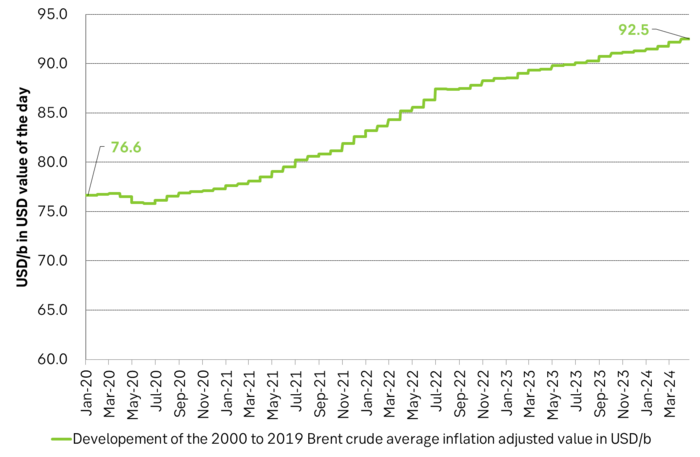
Inflation adjusted Brent crude price versus total US commercial crude and product stocks. A bit above the regression line. Maybe USD 5/b risk premium. But type of inventories matter. Latest big gains were in Propane and Other oils and not so much in crude and products

Total US commercial crude and product stocks usually rise by 4-5 m b per week this time of year. Gains have been very strong lately, but mostly in Propane and Other oils

Last week’s US inventory data. Big rise of 10 m b in commercial inventories. What really stands out is the big gains in Propane and Other oils
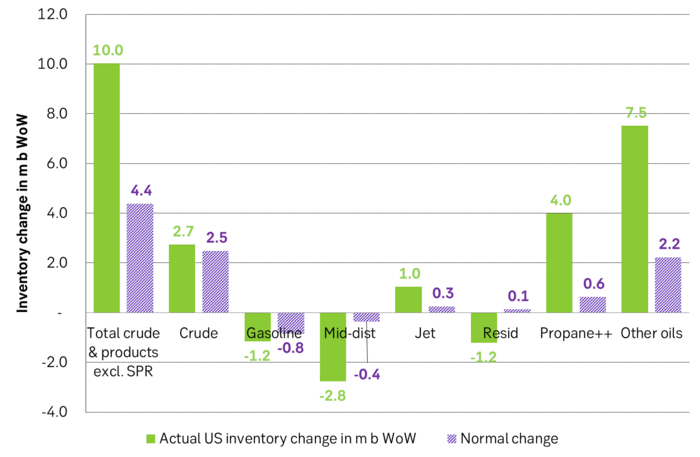
Take actual changes minus normal seasonal changes we find that US commercial crude and regular products like diesel, gasoline, jet and bunker oil actually fell 3 m b versus normal change.

Analys
Nat gas to EUA correlation will likely switch to negative in 2026/27 onward

Historically positive Nat gas to EUA correlation will likely switch to negative in 2026/27 onward

Historically there has been a strong, positive correlation between EUAs and nat gas prices. That correlation is still fully intact and possibly even stronger than ever as traders increasingly takes this correlation as a given with possible amplification through trading action.
The correlation broke down in 2022 as nat gas prices went ballistic but overall the relationship has been very strong for quite a few years.
The correlation between nat gas and EUAs should be positive as long as there is a dynamical mix of coal and gas in EU power sector and the EUA market is neither too tight nor too weak:
Nat gas price UP => ”you go black” by using more coal => higher emissions => EUA price UP
But in the future we’ll go beyond the dynamically capacity to flex between nat gas and coal. As the EUA price moves yet higher along with a tightening carbon market the dynamical coal to gas flex will max out. The EUA price will then trade significantly above where this flex technically will occur. There will still be quite a few coal fired power plants running since they are needed for grid stability and supply amid constrained local grids.
As it looks now we still have such overall coal to gas flex in 2024 and partially in 2025, but come 2026 it could be all maxed out. At least if we look at implied pricing on the forward curves where the forward EUA price for 2026 and 2027 are trading way above technical coal to gas differentials. The current forward pricing implications matches well with what we theoretically expect to see as the EUA market gets tighter and marginal abatement moves from the power sector to the industrial sector. The EUA price should then trade up and way above the technical coal to gas differentials. That is also what we see in current forward prices for 2026 and 2027.
The correlation between nat gas and EUAs should then (2026/27 onward) switch from positive to negative. What is left of coal in the power mix will then no longer be dynamically involved versus nat gas and EUAs. The overall power price will then be ruled by EUA prices, nat gas prices and renewable penetration. There will be pockets with high cost power in the geographical points where there are no other alternatives than coal.
The EUA price is an added cost of energy as long as we consume fossil energy. Thus both today and in future years we’ll have the following as long as we consume fossil energy:
EUA price UP => Pain for consumers of energy => lower energy consumption, faster implementation of energy efficiency and renewable energy => lower emissions
The whole idea with the EUA price is after all that emissions goes down when the EUA price goes up. Either due to reduced energy consumption directly, accelerated energy efficiency measures or faster switch to renewable energy etc.
Let’s say that the coal to gas flex is maxed out with an EUA price way above the technical coal to gas differentials in 2026/27 and later. If the nat gas price then goes up it will no longer be an option to ”go black” and use more coal as the distance to that is too far away price vise due to a tight carbon market and a high EUA price. We’ll then instead have that:
Nat gas higher => higher energy costs with pain for consumers => weaker nat gas / energy demand & stronger drive for energy efficiency implementation & stronger drive for more non-fossil energy => lower emissions => EUA price lower
And if nat gas prices goes down it will give an incentive to consume more nat gas and thus emit more CO2:
Cheaper nat gas => Cheaper energy costs altogether, higher energy and nat gas consumption, less energy efficiency implementations in the broader economy => emissions either goes up or falls slower than before => EUA price UP
Historical and current positive correlation between nat gas and EUA prices should thus not at all be taken for granted for ever and we do expect this correlation to switch to negative some time in 2026/27.
In the UK there is hardly any coal left at all in the power mix. There is thus no option to ”go black” and burn more coal if the nat gas price goes up. A higher nat gas price will instead inflict pain on consumers of energy and lead to lower energy consumption, lower nat gas consumption and lower emissions on the margin. There is still some positive correlation left between nat gas and UKAs but it is very weak and it could relate to correlations between power prices in the UK and the continent as well as some correlations between UKAs and EUAs.
Correlation of daily changes in front month EUA prices and front-year TTF nat gas prices, 250dma correlation.
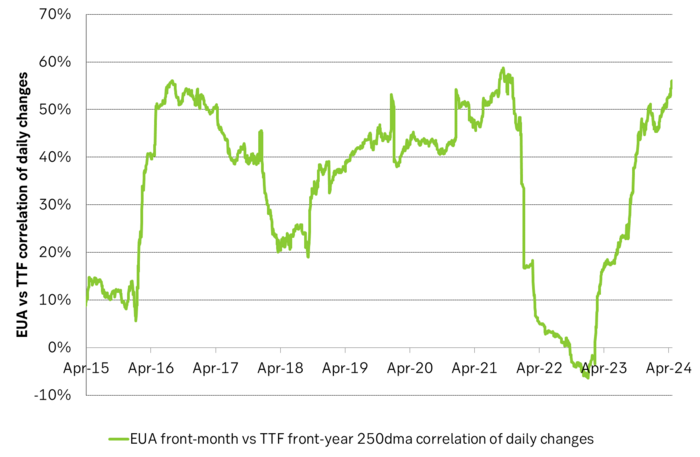
EUA price vs front-year TTF nat gas price since March 2023
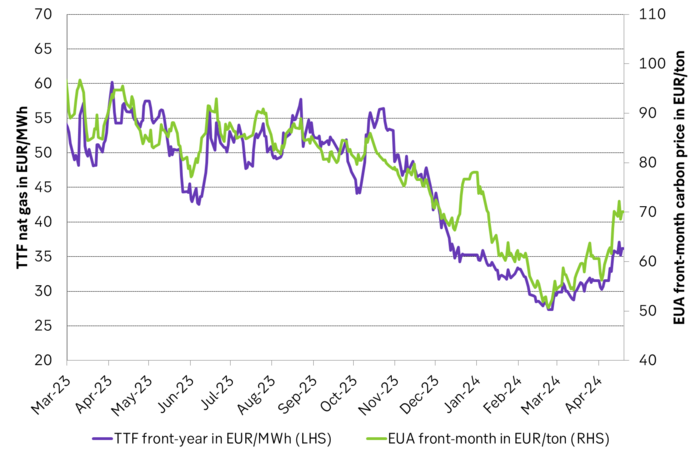
Front-month EUA price vs regression function of EUA price vs. nat gas derived from data from Apr to Nov last year.
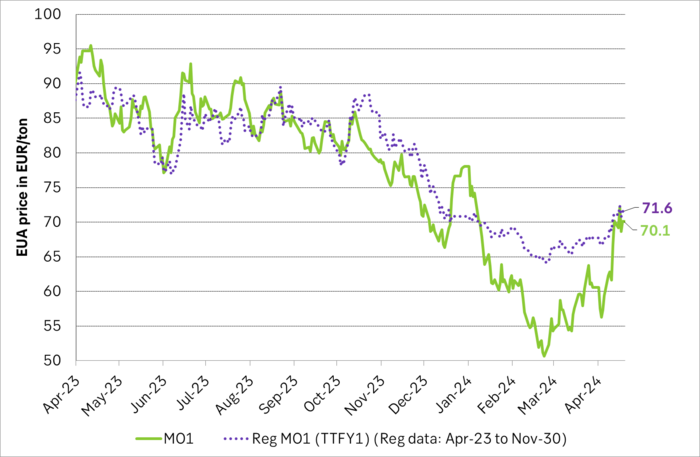
The EUA price vs the UKA price. Correlations previously, but not much any more.
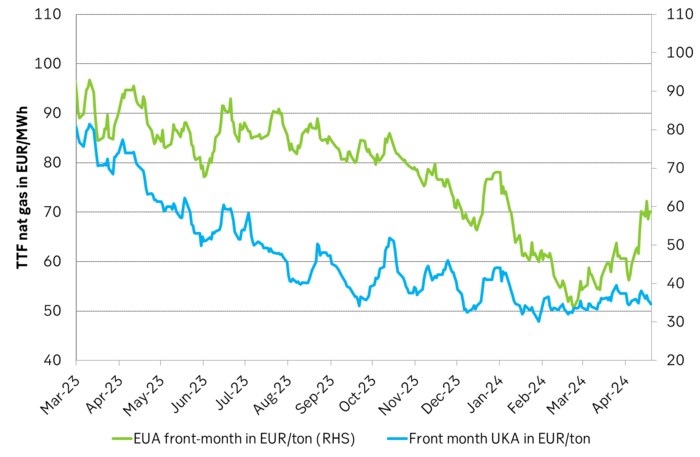
Forward German power prices versus clean cost of coal and clean cost of gas power. Coal is totally priced out vs power and nat gas on a forward 2026/27 basis.

Forward price of EUAs versus technical level where dynamical coal to gas flex typically takes place. EUA price for 2026/27 is at a level where there is no longer any price dynamical interaction or flex between coal and nat gas. The EUA price should/could then start to be negatively correlated to nat gas.

Forward EAU price vs. BNEF base model run (look for new update will come in late April), SEB’s EUA price forecast.
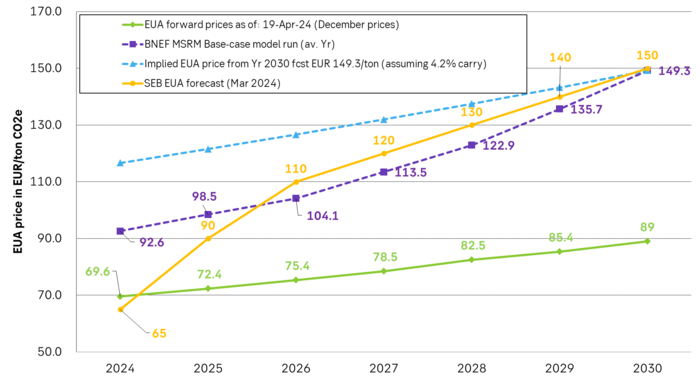
Analys
Fear that retaliations will escalate but hopes that they are fading in magnitude

Brent crude spikes to USD 90.75/b before falling back as Iran plays it down. Brent crude fell sharply on Wednesday following fairly bearish US oil inventory data and yesterday it fell all the way to USD 86.09/b before a close of USD 87.11/b. Quite close to where Brent traded before the 1 April attack. This morning Brent spiked back up to USD 90.75/b (+4%) on news of Israeli retaliatory attack on Iran. Since then it has quickly fallen back to USD 88.2/b, up only 1.3% vs. ydy close.

The fear is that we are on an escalating tit-for-tat retaliatory path. Following explosions in Iran this morning the immediate fear was that we now are on a tit-for-tat escalating retaliatory path which in the could end up in an uncontrollable war where the US unwillingly is pulled into an armed conflict with Iran. Iran has however largely diffused this fear as it has played down the whole thing thus signalling that the risk for yet another leg higher in retaliatory strikes from Iran towards Israel appears low.
The hope is that the retaliatory strikes will be fading in magnitude and then fizzle out. What we can hope for is that the current tit-for-tat retaliatory strikes are fading in magnitude rather than rising in magnitude. Yes, Iran may retaliate to what Israel did this morning, but the hope if it does is that it is of fading magnitude rather than escalating magnitude.
Israel is playing with ”US house money”. What is very clear is that neither the US nor Iran want to end up in an armed conflict with each other. The US concern is that it involuntary is dragged backwards into such a conflict if Israel cannot control itself. As one US official put it: ”Israel is playing with (US) house money”. One can only imagine how US diplomatic phone lines currently are running red-hot with frenetic diplomatic efforts to try to defuse the situation.
It will likely go well as neither the US nor Iran wants to end up in a military conflict with each other. The underlying position is that both the US and Iran seems to detest the though of getting involved in a direct military conflict with each other and that the US is doing its utmost to hold back Israel. This is probably going a long way to convince the market that this situation is not going to fully blow up.
The oil market is nonetheless concerned as there is too much oil supply at stake. The oil market is however still naturally concerned and uncomfortable about the whole situation as there is so much oil supply at stake if the situation actually did blow up. Reports of traders buying far out of the money call options is a witness of that.
-

 Nyheter3 veckor sedan
Nyheter3 veckor sedanGuldpriset når nytt all time high och bryter igenom 2300 USD
-

 Nyheter4 veckor sedan
Nyheter4 veckor sedanLundin Mining får köprekommendation av BMO
-

 Nyheter3 veckor sedan
Nyheter3 veckor sedanCentralbanker fortsatte att köpa guld under februari
-
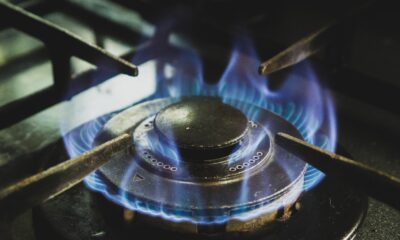
 Nyheter2 veckor sedan
Nyheter2 veckor sedanUSAs stigande konsumtion av naturgas
-
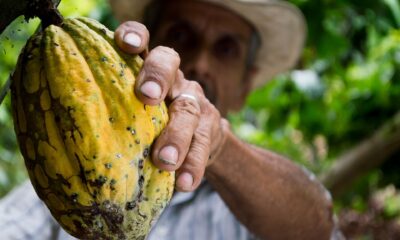
 Nyheter3 veckor sedan
Nyheter3 veckor sedanKakaomarknaden är extrem för tillfället
-

 Nyheter3 veckor sedan
Nyheter3 veckor sedanHur mår den svenska skogsbraschen? Två favoritaktier
-

 Nyheter4 veckor sedan
Nyheter4 veckor sedanBoliden på 20 minuter
-

 Nyheter3 veckor sedan
Nyheter3 veckor sedanBetydande underskott i utbudet av olja kan få priset att blossa upp


